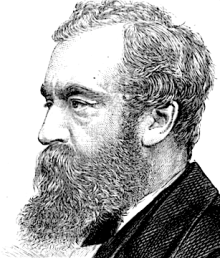
Matthew Digby Wyatt [also known as Sir Matthew Digby Wyatt] was born in Rowde, Wiltshire, England on 28 July 1820 and trained as an architect in the office of his brother, Thomas Henry Wyatt (1807-1880) from 1836. He displayed evidence of his talent as a writer by winning the essay prize of the Architectural Society [the forerunner of the Institute of British Architects, now Royal Institute of British Architects] at the age of sixteen. In 1837 he enrolled at the Royal Academy Schools in London. To further his education, in 1844 he left England for a tour of the Continent, during his time abroad he researched material for the first of his many books, Specimens of Geometrical Mosaics of the Middle Ages (1848). He also made over 1,000 sketches.
He returned to England in 1846 and in 1849 was commissioned by the Society of Arts to accompany Henry Cole (1808-1882) to France and write a report on the International Exposition held in Paris that year. The Society of Arts was impressed by Wyatt's report and he was appointed to the post of secretary to the executive committee of the Great Exhibition in London in 1851. He was also responsible for arranging the exhibits. For his services to the exhibition he was awarded a special gold medal and a premium of £1,000. Two years after the exhibition Wyatt produced his impressive two volume work Industrial Arts of the nineteenth century: a series of illustrations of the choicest specimens produced by every nation at the Great Exhibition of Works of Industry (1853) in which he documented many of the best objects in the exhibitions by means of chromolithography.
In 1852-54 he assisted Isambard Kingdom Brunel (1806-1859) in the design of the decorative ironwork at the Great Western Railway Paddington station in London. In 1855 he was appointed to the post of Surveyor of the East India Company, and from 1855 to 1859 he was honorary secretary of the Royal Institute of British Architects. In 1869 he was made the first Slade Professor of Fine Art at the University of Cambridge, a position he held until 1872.
Wyatt was elected an Associate of the Royal Institute of British Architects (ARIBA) in 1849, and a Fellow of the Royal Institute of British Architects (FRIBA) in 1854. He was awarded the RIBA Gold Medal in 1866. He died at Dimlands Castle in Cowbridge, South Wales, on 21 May 1877
A biographical file on Matthew Digby Wyatt is available on request from the Enquiry Desk, Royal Institute of British Architects Library, London
Throughout the 1860s and 1870s he continued to practice as an architect. Work from these years included the Royal Engineers’ Memorial at the Brompton Barracks, Chatham (1860-61); Christchurch, Coed-y-Paen, Monmouthshire, Wales, (completed 1861); Crimean memorial arch at Chatham (1861), the Indian government stores at Lambeth (1861–64); the old Addenbrooke's Hospital building on Trumpington Street in Cambridge (1863-65); Durbar Court, India Office, Whitehall, London (1864-67); main entrance and shed, Temple Meads station, Bristol (1865-78); the Rothschild Mausoleum in West Ham Jewish Cemetery (1866); Possington Manor, Sussex (1866); Newells, a large private house near Horsham, Sussex (1869); extension of Royal Indian Engineering College, Cooper's Hill, Surrey (1870-71); and Alford House, in Kensington Gore, London (1871-72).
See also:
Source of Images
Cornforth, John. ‘The old India Office’. [The Durbar Court designed by Matthew Digby Wyatt, in collaboration with Gilbert Scott]. Country Life vol. 181, no. 46, 12 November 1987 pp. 164-169.
Directory of British Architects 1834-1914. Compiled by Antonia Brodie, et al. Volume 2: L-Z. London; New York: British Architectural Library, Royal Institute of British Architects/Continuum, 2001
Girouard, Mark. The Victorian Country House. New Haven and London: Yale University Press, revised and enlarged edition, 1979.
Pevsner, Nikolaus. Matthew Digby Wyatt : the first Cambridge Slade professor of fine art: an inaugural lecture. Cambridge: University Press, 1950.
Thorne, Robert. ‘Masters of building: 7. The birth of the high-tech shed - Paddington Station; architect (1850): Isambard Kingdom Brunel, with Matthew Digby Wyatt’. Architects’ Journal vol. 182, no. 46, 13 November 1985 pp. 44-58
'Obituary’. American Architect & Building News vol. 2, 2 June 1877, pp. 169-70
‘Obituary’. The Builder vol. 35, 26 May 1877, p. 541
'Obituary’. The Builder vol. 35, 2 June 1877, pp. 545-47, 550
‘Obituary’. Graphic vol. 15, 1877, p. 549
‘Obituary’. Practical Magazine vol. 7, 1877, p. 128;
‘Obituary’. RIBA Transactions 1877/78, pp. 7-8